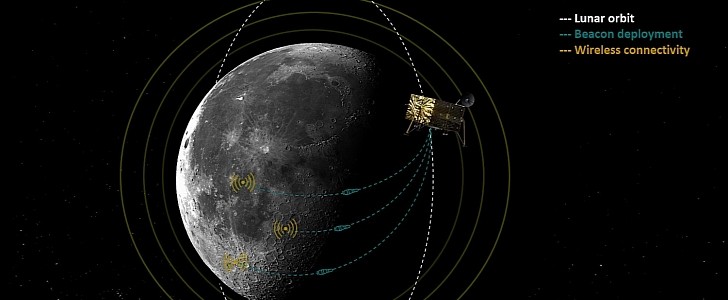It’s not that long since Global Positioning Systems (GPS) came about, but they quickly and forever changed our world. No military organization, no air transportation company, and not one individual could imagine life without GPS nowadays.
Revolutionary as it is, GPS is, for now, a solution limited to our own planet, on account of it being, well, the only one we’re inhabiting. But if all goes well, humanity will reach for the stars soon, starting with the Moon, and that means GPS will be needed elsewhere as well.
In a couple of years’ time, NASA plans to return humans to the Moon, and soon after start building a colony there. That means a lot of people and hardware will be heading for the Moon soon, and navigation solutions are mandatory if we are to be successful in our endeavors.
The idea of developing GPS solutions for the Moon is not new, but entered a new stage earlier this month, after the Air Force Research Laboratory’s AFWERX program awarded a Phase II SBIR contract to Masten Space Systems.
Masten, the guys behind what could be a revolutionary lunar mining system, are currently working on “a lunar positioning and navigation network prototype” that should “enhance cislunar security and improve landing accuracy near resource-rich lunar sites.”
Aside from the obvious advantages of knowing where you or resources are on the Moon, a lunar GPS could “lower spacecraft costs by millions of dollars” by ridding them of the expensive navigation hardware and sensors currently needed for navigation.
Masten was bumped to Phase II after in Phase I it came up with “the concept design for the network prototype that offloads position, navigation, and timing (PNT) beacons from a spacecraft into a dedicated sensor array on the Moon.”
Now, the company will work on actually making the beacons. These beacons are supposed to embed themselves into the surface like a mesh network, enabling “consistent wireless connectivity to lunar spacecraft, objects, and orbital assets.”
Masten plans to test the solution at an unspecified date using the Xodiac lander here on Earth, “to demonstrate payload integration and beacon operations in a terrestrial environment.”
In a couple of years’ time, NASA plans to return humans to the Moon, and soon after start building a colony there. That means a lot of people and hardware will be heading for the Moon soon, and navigation solutions are mandatory if we are to be successful in our endeavors.
The idea of developing GPS solutions for the Moon is not new, but entered a new stage earlier this month, after the Air Force Research Laboratory’s AFWERX program awarded a Phase II SBIR contract to Masten Space Systems.
Masten, the guys behind what could be a revolutionary lunar mining system, are currently working on “a lunar positioning and navigation network prototype” that should “enhance cislunar security and improve landing accuracy near resource-rich lunar sites.”
Aside from the obvious advantages of knowing where you or resources are on the Moon, a lunar GPS could “lower spacecraft costs by millions of dollars” by ridding them of the expensive navigation hardware and sensors currently needed for navigation.
Masten was bumped to Phase II after in Phase I it came up with “the concept design for the network prototype that offloads position, navigation, and timing (PNT) beacons from a spacecraft into a dedicated sensor array on the Moon.”
Now, the company will work on actually making the beacons. These beacons are supposed to embed themselves into the surface like a mesh network, enabling “consistent wireless connectivity to lunar spacecraft, objects, and orbital assets.”
Masten plans to test the solution at an unspecified date using the Xodiac lander here on Earth, “to demonstrate payload integration and beacon operations in a terrestrial environment.”








